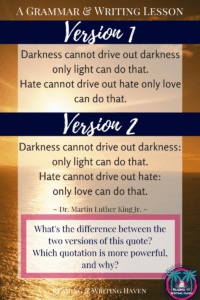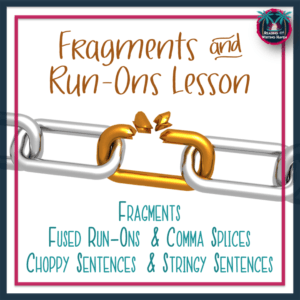Three Grammar and Writing Lessons that Empower Student Authors
Writing is grammar. Grammar is writing. Sure, there are elements of writing that may not be directly related to grammar, such as word choice, citation rules, content, and paragraph organization. Still, the ability to take words and play with them skillfully mainly centers around students’ mastery of grammar. Teaching writing? When creating a writing culture in my classroom, demonstrating how grammar empowers authors is paramount. As I tell my students, “In this classroom, we do “grammaring.”
On my very first high school research paper, I earned a C. Pathetic, I know. Oh, my fifteen-year-old self was pretty devastated at the time. Reflecting on that experience…on the way that letter grade stared me in the face, causing me to question my potential as writer…I can empathize with students who, like my former self, just don’t yet understand how to manipulate language. They haven’t reached the place where they can use words and phrases to purposefully and confidently craft powerful sentences. They’re frustrated, and I completely get it.
When it comes to creating a high school classroom writing culture, I keep this experience from twenty years ago (which still sticks out in my memory like it was yesterday) at the forefront of my planning. At the beginning of the year, I make it a point to show my students how closely intertwined writing and grammar truly are.
Why grammar? It wasn’t until I had a firm understanding of how grammatical concepts and parts can be engineered to create powerful compositions that I myself began to enjoy the writing process. Too often, grammar and writing are treated as separate entities within the study of an English class. As a result, students don’t usually see that without one, we wouldn’t have the other.
For example, can you imagine teaching students how to write a complete sentence without also introducing the concepts of a subject and a verb? With older students, it would be hard to learn how to use advanced transitional elements without studying phrases and clauses. How would students know the comma rules that govern these situations?
Writing is grammar.
On the other hand, if we simply ask students to identify and memorize conjunctive adverbs or to identify faulty parallelism, it doesn’t help them to transfer those skills to practical use. Grammar lessons are not bad. In fact, they are necessary and powerful. But…why teach grammar without showing students how those skills transfer to writing?
Why do we need grammar? Clearly, it’s to make us better writers. Grammar is writing. But, do students really understand that correlation? They need to.
We can build a writing culture in our classroom in which students experience how closely the concepts of writing and grammar are intertwined. How? The sky is the limit, but let’s take a look at some quick and practical lessons you can use to help students understand that in your English class, writing and grammar are friends. They ride the bus together, they camp together, they shop together, they eat together, and they work together. They might as well be married.
GRAMMAR AND WRITING LESSONS
The Impossible Task
This one is simple. Just ask your students to write a whole paragraph without using any grammatical elements. Then, observe what they do. Try not to give them any further direction, and don’t tell them it’s an impossible task up front. If students have a solid understanding of grammar, they won’t write anything. Similarly, if they have no understanding of grammar, they might not write a single word. Every aspect of writing — from the parts of speech that make up parts of sentences to the punctuation that corresponds with sentence types — is a grammatical element.
After giving students some time to work, don’t tell them the answer. It’s time to put on their thinking caps. Ask them…What is grammar? See what they know. Use probing questions to continue the discussion. For instance. Is punctuation grammar? Did you write any words on your paper? What part of speech are they? Are parts of speech grammar? Through questioning and thoughtful discussion, students should arrive at a final conclusion…without using grammatical elements, they can’t write anything.
What’s the purpose? This lesson should help students discern that to truly understand grammar gives them power over the English language. It allows them to mold essays with confidence and finesse. Grammar is writing.
When to use it: The impossible task is perfect for the beginning of the year or for any time you are preparing to start your first grammar unit.
Quotation Analysis
This lesson is quick. It could even be used as a bell ringer. Choose a quote that you want to share with students. The quote should illustrate strong usage of a grammatical concept. For instance, if you’re teaching students about colons, make sure the quotation you select has notable punctuation. Then, create two versions of the quotation: one that uses the punctuation, and one that omits it. Like this:
Now, discuss with students which quote is more effective. Don’t point out any differences. Just have them study the two quotes and come to their own conclusions. After students arrive at the realization that the dramatic usage of colons makes Version 2 more effective, have a discussion about how punctuation is an element of grammar that gives students control over their writing. Talk about how authors use language to impact their audiences. Explain that students can use grammar to make an emotional impact on readers if they care enough to study the rules and master them.
What’s the purpose? The point of this lesson is to use an inductive approach to learning. By studying and analyzing the two different quotations, students will be able to develop a general writing rule that is based on grammar. Hopefully, they will see that their messages carry more weight when they use punctuation meaningfully.
When to use it: This lesson would be perfect at any time of the year. It would work at the beginning of the year as an activity to establish a writing culture. Depending on which skill is emphasized, it would also work well as a hook for a grammar lesson.
Framing the Lesson
Throughout the year, I’ve found it extremely beneficial to frame my grammar lessons with writing. Often, I project a controversial statement, a humorous meme, or an insightful political cartoon up on the board. If I’m feeling generous, I play a short video clip. Commercials work well. Then, I ask students to write a paragraph analyzing the prompt that corresponds to the hook. I cap writing time at about five minutes so that I have enough time for the next segment of the lesson.
After students complete their responses, I have them tuck their answers in their folders. I really don’t even want them to think about what they have written until the end of the period. This is the time when I begin the day’s grammar lesson (fragments, run-ons, commas, etcetera).
At the end of the period, I ask students to return to their writing from the beginning of class. Before they read, I give them a purpose: They are to find any instances where they can improve upon their writing as it pertains to that day’s grammar lesson. Many times, students find sentence structure and punctuation errors easily. Other times, I have them trade with a partner who looks at the writing sample with fresh eyes.
Do students always find an error that pertains to that lesson? No, not necessarily. But…many do. I ask some of the students who have made these mistakes to kindly volunteer their original and revised sentences.
What’s the purpose? The point of this lesson is to show students how grammar concepts directly relate to their own writing. There’s no time gap. Students write, learn the skill, and immediately revisit their response, combing through it for grammatical infractions.
When to use it: This lesson is most successful with grammar skills that directly relate to writing, such as those I mentioned. Indirect skills don’t work as well. To illustrate, students need to understand direct objects to be able to identify gerund and infinitive phrases. However, it would be silly for me to ask students to find direct objects in their own writing. Are they there? Possibly. But, what’s the point? This lesson is more effective when used with grammar skills that clearly impact writing competency.
Without grammar, what is writing? While the study of grammar is often approached differently than the study of writing, the two have a symbiotic relationship. Let’s help our students appreciate grammar’s relevance by asking them to identify its usage and analyze its impact within mentor texts and their own daily writing. Should we teach grammar? YES! But, let’s do more.
In part, creating a writing culture means we are building an environment in which students can see how various aspects of our language coordinate and overlap. We can empower our students to become the best writers possible and leave them with lessons that will impact them positively for years to come.
My senior year, four years after earning a C on my first ever high school research paper, I finally had an English teacher whose approach to writing and grammar resonated with me. The lessons I learned from him about how writing and grammar interrelate? I’ll never forget them. He didn’t just teach me about sentence parts and construction rules. He equipped to become the author I always wanted to be (but was never sure I could be). That? It’s something worth passing on to my own students.
RELATED RESOURCE
This fragments and run-ons lesson features the “framing” approach to embedding writing in grammar instruction. Click on the image below to view the assignment details.




